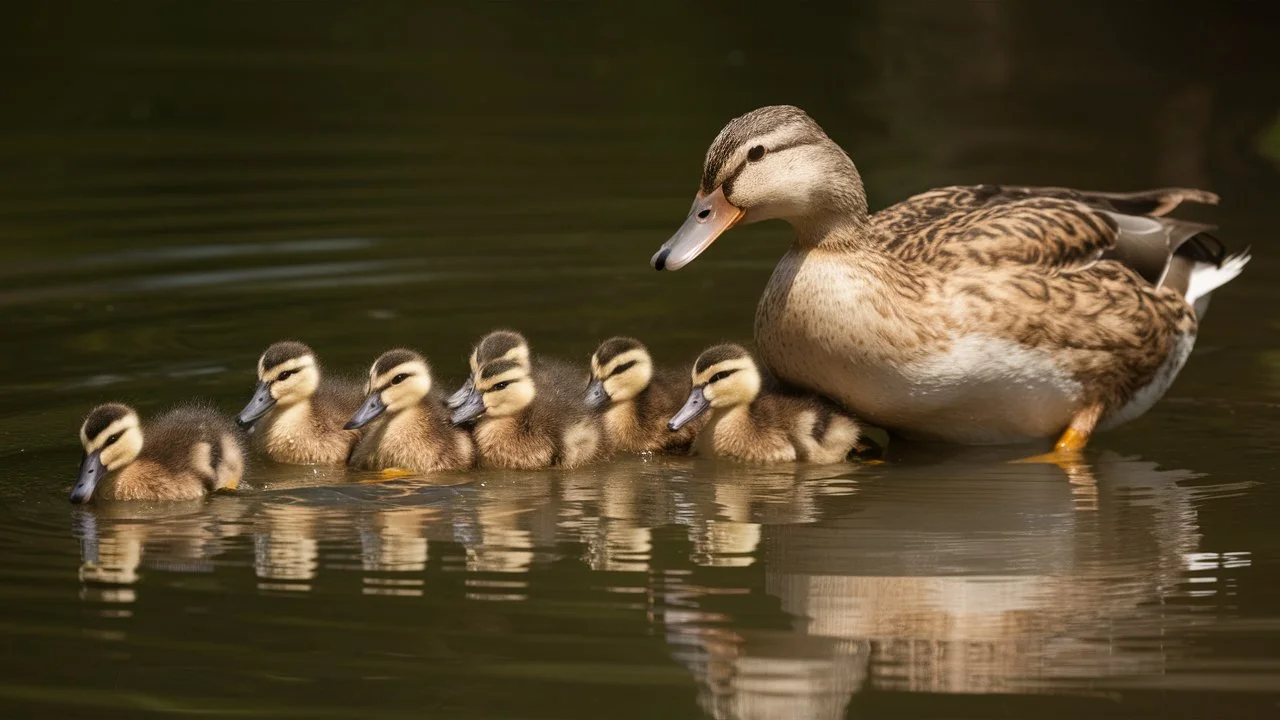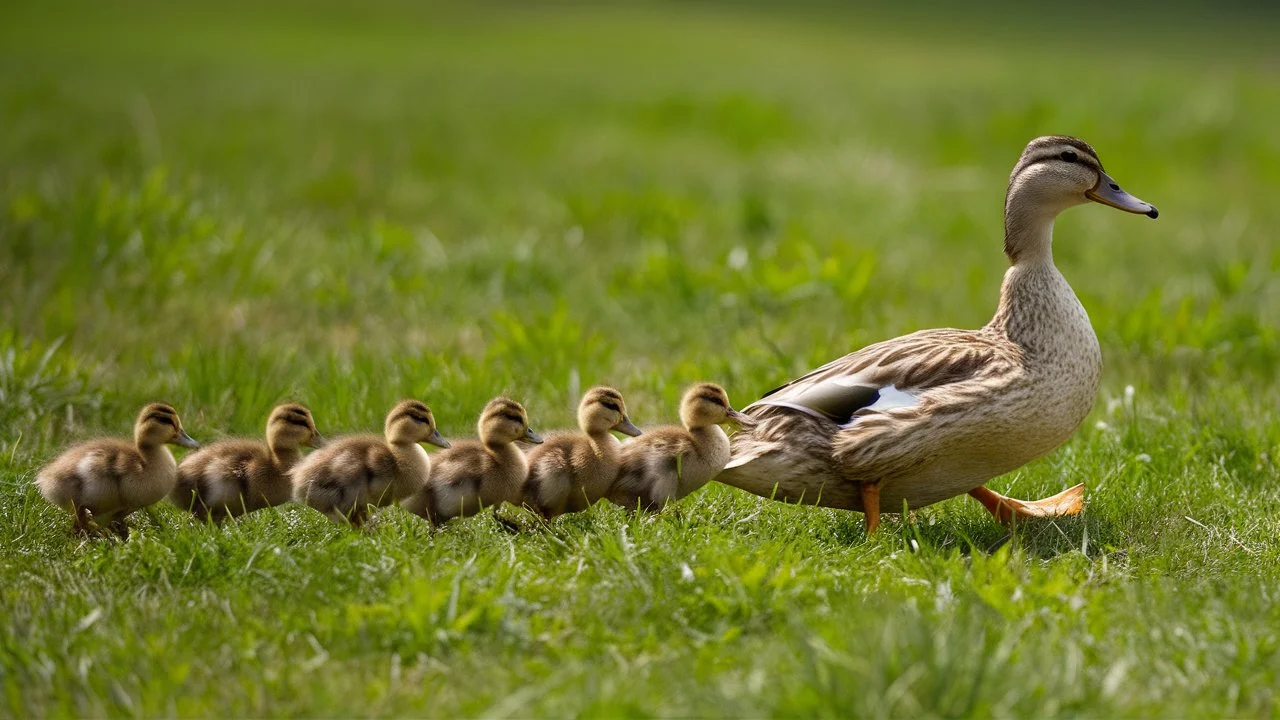When we think of ducks, images of serene ponds, graceful swimming, and gentle quacking come to mind. But have you ever wondered if ducks care about their babies? The answer is a resounding yes. Mother ducks, or hens, are incredibly devoted to their ducklings, displaying a wide range of behaviors to protect and nurture their young.
From the moment they lay their eggs to the time their ducklings are ready to face the world independently, mother ducks go to great lengths to ensure their offspring’s safety and well-being. This article will explore the various ways in which ducks care for their babies, highlighting the dedication and love that characterize these remarkable waterfowl mothers.
Yes, ducks care about their babies. Mother ducks, or hens, are very devoted to their ducklings. They protect their eggs by choosing safe nesting spots and incubating them until they hatch. After hatching, mother ducks lead their ducklings to water, teach them how to swim and find food, and keep them safe from predators. Throughout this period, mother ducks stay vigilant and use various tactics to ensure the well-being and survival of their young.
Do Ducks Care About Their Babies?
Yes, ducks care deeply about their babies. Mother ducks, also known as hens, exhibit a range of behaviors that demonstrate their care and protection for their young, from the moment they lay their eggs until the ducklings are mature enough to fend for themselves. Let’s explore how mother ducks show care for their babies in simple and easy-to-understand terms.
Related reading: Do Male Ducks Kill Ducklings?

Laying and Incubating Eggs
A mother duck begins caring for her babies even before they hatch. She selects a safe and hidden place to build her nest, often in tall grass, under bushes, or in other secluded spots. This helps to protect the eggs from predators like foxes, raccoons, and even larger birds.
Once she lays her eggs, the mother duck stays with them to keep them warm and safe. This process is called incubating. She spends most of her time on the nest, leaving only briefly to eat and drink. The warmth from her body helps the eggs to develop properly, ensuring that the baby ducks inside grow strong and healthy.
Hatching: Welcoming the Ducklings
When the eggs are ready to hatch, the mother duck remains close by. She may make soft clucking noises to encourage and comfort the hatching ducklings. Once all the ducklings have hatched, she leads them to water, which is their natural habitat. This journey can be dangerous, but the mother duck stays alert, watching for any threats and guiding her ducklings safely.
Leading to Water: A Protective Journey
The mother duck’s care is evident as she leads her ducklings to water. She keeps them in a straight line and uses loud quacks to keep them together and alert them to any danger. If a predator approaches, the mother duck will use various tactics to protect her babies. She might spread her wings, hiss, and even charge at the predator to scare it away. Sometimes, she pretends to be injured to lure the predator away from her ducklings. This behavior, known as the “broken-wing act,” is very effective in protecting her young.
Teaching Survival Skills
Once they reach the water, the mother duck’s care continues. She teaches her ducklings how to swim, dive, and find food. Ducklings learn by watching their mother and copying her movements. The mother duck keeps her ducklings close, forming a tight group to make it harder for predators to attack them.
Feeding: Ensuring They Eat Well
Feeding is a crucial aspect of a duckling’s survival, and the mother duck plays a key role in this. She leads her young to safe feeding areas where they can find insects, small fish, and plants. She shows them how to dabble, which means to dip their heads under the water to find food. While the ducklings feed, the mother duck stays alert, ready to warn them of any danger with loud quacks.
Nighttime: Staying Safe
At night, the mother duck finds a safe place for her and her ducklings to sleep. This could be on the water, where it’s harder for land predators to reach them, or in a hidden spot on land. While the ducklings sleep, the mother duck remains watchful, often sleeping with one eye open to stay aware of any threats.
Gradual Independence
As the ducklings grow, they become more independent, but the mother duck continues to watch over them and teach them important survival skills. She helps them learn how to avoid danger, find food, and stay together as a group. Her care is vital during the first few weeks of their lives, ensuring they grow into strong, independent ducks.
How do mother ducks protect their young?
Mother ducks, also known as hens, are very protective of their ducklings. From the moment the eggs are laid until the ducklings are strong enough to fend for themselves, a mother duck’s main job is to keep her young safe. This article will explore the various ways in which mother ducks protect their young, using simple and easy-to-understand language.

The Beginning: Laying and Incubating Eggs
A mother duck begins her journey of protection when she lays her eggs. She chooses a safe and hidden place to build her nest, often in tall grass, under bushes, or in other secluded spots. This helps to keep predators, such as foxes, raccoons, and even larger birds, from finding the eggs.
Once the eggs are laid, the mother duck sits on them to keep them warm. This is called incubating. She will spend most of her time on the nest, only leaving briefly to eat and drink. The warmth from her body helps the eggs to develop properly, ensuring that the ducklings will hatch healthy and strong.
Hatching: The First Steps of Protection
After about 28 days of incubation, the ducklings begin to hatch. This is a vulnerable time for them because they are small and weak. The mother duck stays close by, watching over the nest to ensure that no predators come near. She may also make soft clucking noises to comfort the hatching ducklings.
Once all the ducklings have hatched, the mother duck leads them to water. This is often the first big journey for the ducklings, and it can be dangerous. The mother duck is always alert, ready to defend her young if needed.
Leading to Water: The Big Move
Ducks are water birds, and young ducklings need to get to water quickly after hatching. The mother duck leads her ducklings in a straight line to the nearest pond, lake, or river. During this journey, she is extremely watchful. She will quack loudly to keep her ducklings together and alert them of any danger.
If a predator approaches, the mother duck will use various tactics to protect her young. She may spread her wings, hiss, and even charge at the predator to scare it away. Sometimes, she will pretend to be injured to lure the predator away from her ducklings. This behavior is called the “broken-wing act,” and it can be very effective in distracting predators.
On the Water: Teaching Survival Skills
Once they reach the water, the mother duck’s protective duties continue. She teaches her ducklings how to swim, dive, and find food. Ducklings learn by watching their mother, copying her movements, and listening to her calls.
In the water, the mother duck keeps her ducklings close, usually forming a tight group. This makes it harder for predators to single out and attack a duckling. The mother duck is always on the lookout for danger, such as large fish, snapping turtles, and birds of prey. She will use her body to shield her ducklings if needed.
Feeding: Finding Food Safely
Feeding is another crucial aspect of a duckling’s survival. The mother duck leads her young to safe feeding areas where they can find insects, small fish, and plants. She shows them how to dabble, which means to dip their heads under the water to find food.
While feeding, the mother duck stays alert for any signs of danger. If she senses a threat, she will quack loudly to warn her ducklings, who will quickly gather around her for protection. This constant vigilance helps to ensure that the ducklings get enough food to grow strong and healthy.
Nighttime: Keeping Safe
Nighttime can be especially dangerous for ducklings, as many predators are more active after dark. The mother duck finds a safe place for her and her ducklings to sleep. This could be on the water, where it’s harder for land predators to reach them, or in a hidden spot on land.
While the ducklings sleep, the mother duck remains watchful. She will sleep with one eye open, ready to react to any threats. Her presence alone is often enough to deter many predators.
Growing Up: Gradual Independence
As the ducklings grow, they become more independent. However, the mother duck continues to watch over them and teach them important survival skills. She helps them learn how to avoid danger, find food, and stay together as a group.
The mother duck’s protection is vital during the first few weeks of the ducklings’ lives. By the time they are a few months old, the ducklings are usually strong enough to look after themselves. They will start to explore more on their own, but they still stay close to their mother and siblings for safety.
Conclusion: The Mother Duck’s Role
In conclusion, a mother duck plays a crucial role in protecting her young. From choosing a safe nesting spot and incubating the eggs to leading the ducklings to water and teaching them how to survive, her efforts are vital for the ducklings’ survival. Through her constant vigilance and protective behaviors, she ensures that her young have the best chance of growing into healthy, independent ducks.
Mother ducks show that the bond between a mother and her young is strong and full of love and care. Their actions remind us of the importance of family and the lengths to which parents will go to protect their children.

